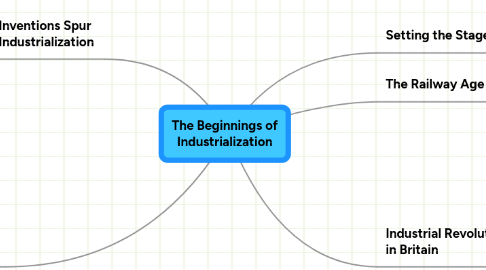The Beginnings of Industrialization
by Brooke Gibson


1. Inventions Spur Industrialization
1.1. In 1733 a machinist named John Kay made a shuttle that sped back and forth on wheels
1.1.1. This machine doubled the amount of work a weaver could do in a day
1.2. Wool, linen and cotton were the first industries to be transformed
1.3. Around 1764 a textile worker James Hargreaves invented a spinning wheel he named after his daughter
1.3.1. The spinning wheel allowed the spinner to work eight threads at a time
1.4. In 1769 Richard Arkwright invented the water frame
1.4.1. This machine used waterpower from rapid streams to drive spinning wheels
1.5. Englands cotton came from plantations in the American south in the 1790s
1.5.1. In 1793 Eli Whitney invented the cotton gin, which multiplied the amount of cotton that could be cleaned
1.5.2. In 1790 cotton production skyrocketed from 1.5 million to 85 million pounds in 1810
2. Improvements in Transportation
2.1. In 1765 James Watt figured out a way to make the steam engine work faster
2.1.1. New node
2.2. In 1774 watt joined a buisinessman named Matthew Boulton who was an entrepreneur and paid Watt to build better engines.
2.3. Robert Fulton built a steamboat called the clermont, which made its first successful trip in 1807
2.4. In the 1800s John Mcadam equipped road beds with a layer of large stones for drainage
3. Setting the Stage
3.1. The industrial revolution began in the 1700s.
3.1.1. Refers to machine made goods that began in England
4. Industrial Revolution Begins in Britain
4.1. Jethro Tull was on of the first scinetific farmers
4.1.1. New node
4.2. In about 1701 Jethro came up with an invention called the seed drill
4.2.1. This allowed farmers to sow seeds in well-spaced rows at specific depths
4.3. Crop rotation proved to be one of the best developments by the scientific farmers.
4.4. In the 1700s Robert Barkwell increased his mutton output by allowing only his best sheep to breed.
4.5. Industrialization is the process of developing machine production of goods.
4.5.1. Growing overseas trade, economic prosperity, and a climat of progress led to the increased demand for goods
